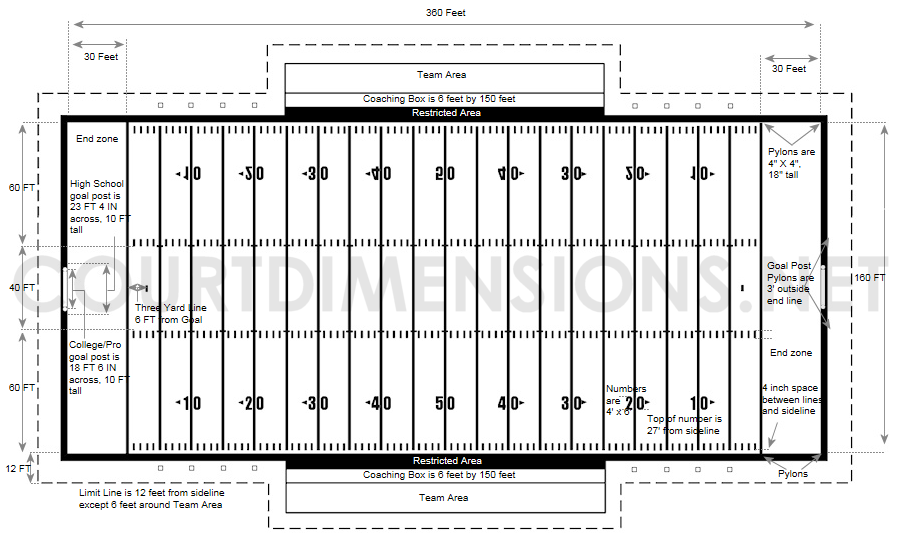Football Field Dimensions
Football Field Dimensions & Measurements
The Basic Football Field
Differences Between College, Professional and High School Football Fields
The number one difference between high school and college/pro football fields is the goal post. The width of the goal posts are 23 feet, 4 inches for high school as compared to 18 feet, 6 inches for college and pro ranks. All goal post are 10 feet from the ground. There should be padding on the goal post from the ground up to 6 feet from the ground.
You’ll also see a “G” on high school fields where the goal line is located. It should also be noted that small signs are usually placed on high school fields on the 10, 20, 30, 40, and 50 yard lines outside the field as a visual aid for the players.
In professional football fields, the coaches and team’s box dimensions may vary a little from college or high school.
Quick Facts About Football Field Measurements
How long is a football field?
From end zone to end zone, it is 100 yards or 300 feet. Counting the end zones, it’s 360 feet long.
How tall are the goal posts on a football field?
At least 20 feet in high school, 30 feet in college and pro.
How wide is a football field?
140 feet.
What is the limit line on football field?
Typically the boundary for fans and/or media.
How long is a Canadian football field?
110 yards from goal to goal, which is 10 yards longer than US football fields.
What size are the marks and lines on a football field?
Typically 4 inches wide.
From Chaotic Kickoff to Cultural Juggernaut: The Legacy of Football
North American football, or “gridiron” as it’s sometimes called, reigns supreme in the United States. The National Football League (NFL) boasts the highest revenue among major sports leagues, drawing in millions of fans every week. High school and college programs overflow with enthusiastic players, dreaming of gridiron glory. But this seemingly modern phenomenon has surprisingly humble and often chaotic origins.
While most of the world uses the term “football” to refer to what Americans call “soccer,” our football sprouted from a fascinating mix of two very different sports: soccer and rugby. The very first collegiate game, played on a brisk November 6th in 1869 between Rutgers and Princeton, resembled a far cry from the streamlined game we know today. Imagine a chaotic rugby match with 25 players per side allowed to use any body part – feet, hands, head, even sides! – to kick or bat a round ball around the field. Scoring was equally wild, with points awarded for kicking the ball between goalposts or through the opponent’s goal area.
Enter Walter Camp, a Yale rugby player with a vision for a more strategic game. During the 1880s, Camp’s rule changes became the cornerstone of American football. He whittled teams down to the 11-player squads we see today, introduced the line of scrimmage and the snap, and laid the foundation for the concept of downs, forever altering the flow and strategy of the game. Interestingly, the iconic forward pass, a staple of modern football, wasn’t legalized until 1906 due to concerns about player safety!
The professional era of football boasts an equally intriguing origin story. William “Pudge” Heffelfinger, forever etched in football lore, became the first professional player on November 12, 1892. Back then, professional wasn’t synonymous with millions of dollars. Heffelfinger received a hefty (for the time) $500 to suit up for the Allegheny Athletic Association against the Pittsburgh Athletic Club. This wasn’t quite the start of a glamorous professional league, but it planted the seed for what would become the NFL.
The National Football League itself arrived in 1920, a merger of several regional leagues. The early years were rough-and-tumble affairs, with teams constantly folding and reforming. However, by 1922, the NFL established itself as the premier professional league, laying the groundwork for the multi-billion dollar industry it is today.
The “gridiron” nickname for the sport arose from the field’s distinctive markings in the early 1900s. These lines resembled a real-life gridiron for cooking, and the name stuck even after the field design evolved. Another interesting tidbit: the iconic orange pylons at the end zones weren’t introduced until the 1970s! Before that, teams used flags or even buckets of lime to mark the boundaries.
American football’s journey from chaotic rugby roots to a cultural phenomenon is a testament to human ingenuity and its ability to adapt. The rules have been constantly tweaked over the years, focusing on player safety while maintaining the strategic chess match and electrifying athleticism that keeps fans glued to their seats. From the high school marching bands and the roar of the crowd to the multi-million dollar contracts and the iconic halftime shows of the Super Bowl, American football has become deeply woven into the fabric of American culture.

